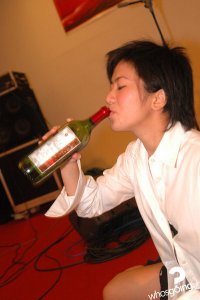MENDOZA, ARGENTINA
As a threatening cloud looms on the horizon, Pedro Marchevsky lingers among the dense rows of ripening vines and prays it won't bring hail.
Luckily for him, Mother Nature is not the only one controlling weather anymore. Humans have intervened here also to reduce the damage caused by hail.
Hail, a major threat to grapes during growing season, has long been a part of weather history in Mendoza, heart of Argentina's wine country.
Despite being shaded and sheltered by the eastern slope of the Andes mountains, the province of Mendoza, which produces 70 percent of all Argentine wine, still needs stronger protection from intense storms. As the fifth-largest wine producer in the world, Argentina is willing to do almost anything to save its crops.
The anti-hail movement, founded in 1974, is Mendoza's response to the severe weather patterns that constantly endanger wine varieties like Malbec.
Before, says Eduardo Martín, director of Argentina's Agriculture and Climate Contingency Control Group, "Mendoza lost 10 percent of its annual cultivation each year as a result of hailstorms. Now it only loses 3 to 5 percent maximum."
It's an impressive achievement — and the way it's been accomplished is equally remarkable.
"Hailstorms used to be very localized and the hail itself was large," explains Marchevsky, co-owner of Mendoza's family-owned Dominio del Plata Winery. His blond hair blows in the relentless wind before settling on his forehead, his uneasiness at the thought of hail wrinkling his youthful face.
As he pops a Malbec grape into his mouth, his expression relaxes. "Luckily," he adds, sighing with relief, "the hail is now much smaller in size."
As a result, in Argentina this natural phenomenon no longer poses such a threat to the delicate vines. This transformation, often mistakenly attributed to climate change, is in fact a result of human intervention.
Cloud seeding, a project funded by the Mendoza province government, is the process of injecting chemicals into clouds to alter precipitation. This practice has been common in Mendoza for 30 years.
By dropping silver iodide particles, which have a similar crystalline structure to ice particles, into a cloud, says Martín, "we are able to modify its precipitation." The majority of the moisture within the cloud condenses to water droplets. For whatever does become solid, the result will be hail that is smaller, he says.
Although silver iodide is the main chemical in the fight against hail today in Mendoza, up until 1981 it was lead iodide. Upon realizing the contaminant effects of lead, silver became the new choice.
From 1978 to 1993 in Mendoza, firework-sized rockets were launched into the clouds containing the chemicals. In 1998 the effort switched to aircraft that fire a silver-iodide flare while passing through the cloud.
According to Martín, the silver iodide does not produce "one trace of contamination." Precipitation samples tested at a local university for silver never reached the minimum level of contamination, Martín assures.
Other scientists are not so sure. While many worry about the consequences of the silver on water and soil quality because it, like lead, is a heavy metal, others criticize the operational part of the program.
"The cloud seeding should be much more localized," says Manuel Pulido, physics lecturer at the Argentine National University of the Northeast. He criticizes the fight against hail for its lack of future weather projections, indicating that its proponents are blindly going into the fight.
"It's hard to believe that such a program doesn't have the essential tools for determining probable places and time of hail formation," adds Pulido. He claims that the cloud seeding is done without proper diagnostics, including a local predictive storm system. Without these figures, says Pulido, cloud seeding is done in areas that may not have even resulted in hail formation in the first place.
Despite such disapproval, the process of seeding clouds continues. However, there are new weapons in the fight against hail. Over the last decade, protective nets have been sprouting all across Argentine vineyards.
"Hail-protective nets are the most efficient way to combat the damage that in just minutes can destroy an entire harvest and a vineyard," says José Alberto Zuccardi, owner of Zuccardi Family Vineyard in Mendoza.
"Each year we invest in renovating and increasing the quantity of plots with the metallic screens," he explains.
But metallic nets, which are surprisingly similar to window screens, are not the only option. In Mendoza, plastic nets are much more common due to their more reasonable price. The plastic netting, which varies in color, is flexible and sheer to the touch but still provides the same benefit of protection against hail.
The nets hang loosely over the maturing vines and clusters of ripe, indigo grapes. The mesh patterns are so fine that they can obstruct sunlight, an initially worrisome side effect because sunlight is key for fruit-bearing vines.
Nonetheless, according to most wine industry experts, the amount of sunlight blocked by the nets, about 10 to 30 percent, is not enough to affect the grape-growing process.
For some, a little extra shade is even considered beneficial, especially in wine-producing regions with excess solar radiation — comparable to that found in the deserts of Southern Arizona.
As hailstorms have begun to have serious impacts on the Arizona wine industry in recent years, wine producers in the region are considering making a similar netting investment.
"The last three years have been half crops," says Kent Callaghan, owner of Elgin's Callaghan Vineyard. "We're seeing much more violent weather; (it's) been bizarre."
Just last year, Elgin experienced three hailstorms while the grapes were ripening. Callaghan, who can recall to the day when hailstorms have hit his vineyard explains, "Believe me, when you get hail, it's a major problem."
The increase in extreme weather patterns in Arizona is causing Callaghan to consider the installation of protective netting systems.
The experts he's consulted, he says, laughing, tell him to "get in contact with the Argentines."
Mia Mitchell
skip to main |
skip to sidebar




Enhance the pleasure that you get from wine by sharing your experiences, knowledge, news articles and facts about the elixir of the gods and bacchanalia on earth by emailing: bacchusforyou@bellsouth.net

ORIGINAL BACCHANALIAN CREATION

BACCHANALIAN WINE GLASS

I LOVE WINE, BUT I NEED TO LEARN HOW TO DRINK IT

Related Links
Blog Archive
-
▼
2008
(305)
-
▼
July
(71)
-
▼
Jul 01
(17)
- RAZOR'S EDGE
- In Argentina's grape-growing region, hail-control ...
- Voga wine launches in UK
- They’re going to kill French wine
- CFA Reveals Alcohol, Calories and Carbs in Top Sel...
- Setting the perfect temperature for a beer, glass ...
- First wine institute to be set up near Pune
- Elegant wine accessory designed to accelerate the ...
- B. Napa's ``CRUSH'' Documentary Wins Top Award at ...
- Cornell Study identifies inconsistencies in tradit...
- Assemblymember Evans Sends Governor Legislation He...
- PRINCE CHARLES IS USING ENGLISH WINE AS FUEL!
- AUSTRALIA AND UK REMAIN HEALTHY
- Constellation Beats Expectations
- Bordeaux En Fleur
- The top 5 things to consider when planning a wine ...
- Touring Bordeaux
-
▼
Jul 01
(17)
-
▼
July
(71)
How Much Did The Best Bottle of Wine You Ever Drank Cost?
CONTACT INFORMATION
TO SUBMIT A POST, TO BE PUT ON THE MAILING LIST, TO HAVE QUESTIONS ANSWERED, ETC.
EMAIL: